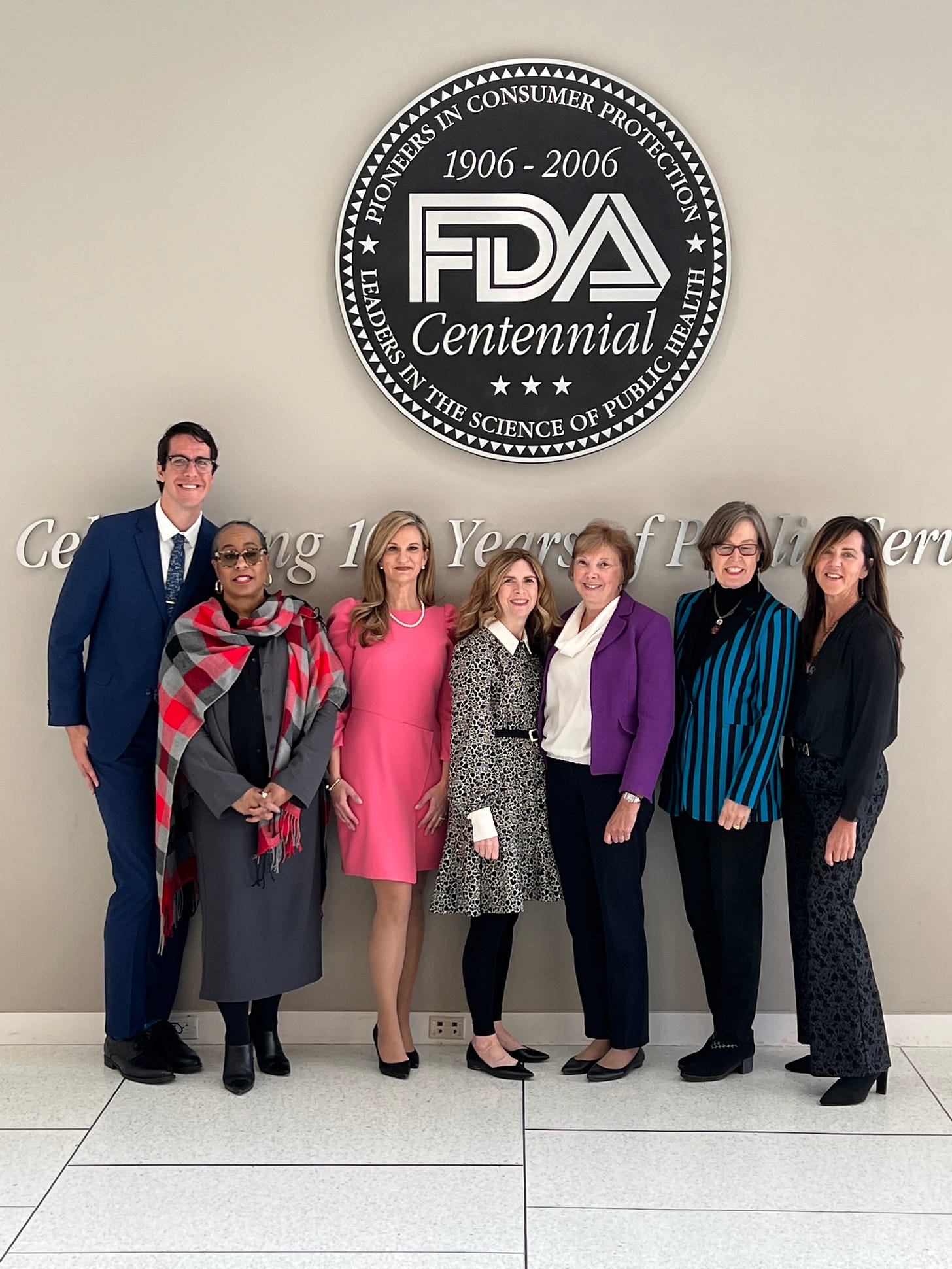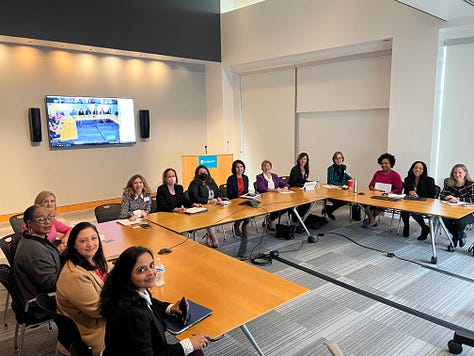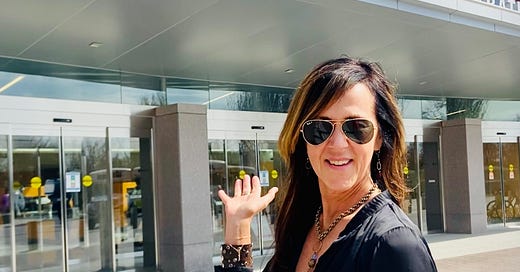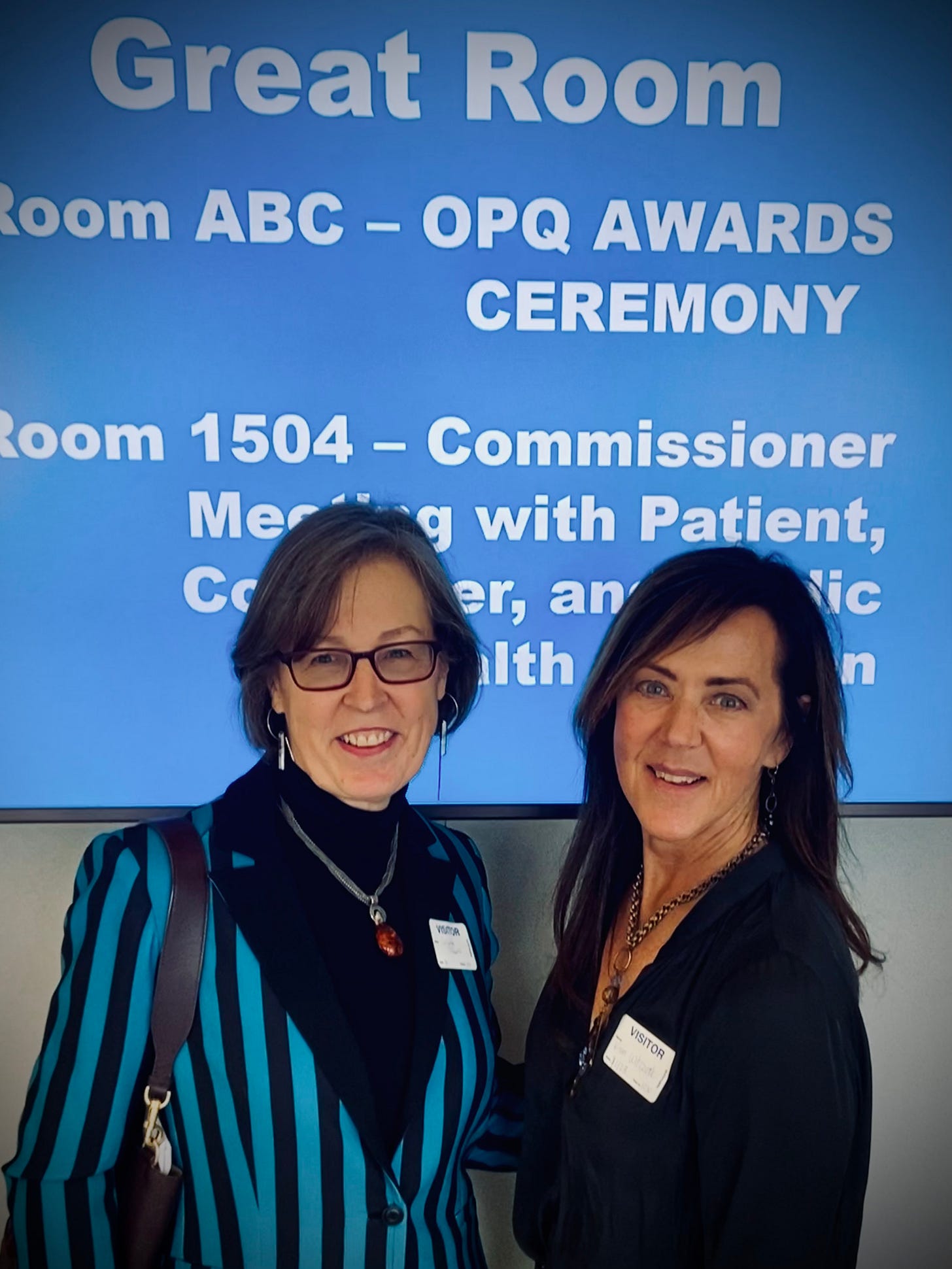After three years, it’s really good to finally be back at the FDA headquarters. While I appreciated the pivot of using virtual meetings during the beginning of the pandemic, they should never replace in person meetings.
I have been going out to the FDA for almost 20 years … whether it is meeting with FDA officials about specific drug safety issues like antidepressants and suicide; speaking before multiple FDA Advisory Committees on a variety of drug safety and communication issues, or reviewing new drugs coming to market as Consumer Rep on the FDA Psychopharmacologic Drug Advisory Committee. I learned long ago that magic happens when you show up.
Last week we had our first meeting with the new FDA Commissioner Dr. Califf and his leadership team since the pandemic started.
Patient, Consumer, and Public Health Coalition
Woodymatters, the drug safety organization that I co-founded after the death of my husband in 2003 is a member of the DC-based Patient, Consumer, and Public Health Coaltion. The coalition is made up of individual and non-profit organizations representing the interests of patients, consumers, healthcare professionals, scientists, and public health experts and advocates. We are independent and make sure the non-conflicted, real world consumer voice is presented. We want to protect patients from bad or questionable products while pushing for transparency. What sets us apart from other patient and disease groups is we do NOT take funding from pharmaceutical companies.
Since I have been personally pushing the FDA to return to in person FDA Advisory Committee meetings, I felt it was important that I showed up despite costing me money out of my own pocket. Unfortunately, not all our coalition members could travel to the FDA so they participated in meeting virtually. This is why I am a fan of having option for hybrid meetings.

Official Coalition Summary
We had 45 minutes with the Commissioner. Given the limited time, here are the topics we focused on: 1) An overview of what makes our consumer/public health perspective different from the perspective of industry-funded patient or medical organizations and the importance of having diverse representatives concerned with safety and harms; 2) Our commitment to scientific evidence based on patient centered outcomes and reducing the misinformation and controversies that have undermined trust in the FDA; 3) Accelerated Approval programs; and 4) Suggestions for improving transparency and ensuring appropriate criteria for FDA Advisory Committees.
FDA Attendees included: Commissioner Robert Califf, Peter Marks (Director, CBER), Owen Faris (OPEQ Principal Deputy Director, CDRH), Julia Tierney (Chief of Staff, Office of the Commissioner), Jacqueline Corrigan-Curay, (Principal Deputy Director, CDER), Dayle Cristinizio (Director, Stakeholder Engagement, Office of External Affairs), Hilary Maston (Chief Medical Officer), Namandje Bumpus (Chief Scientist, AdCom responsibilities), Kaveeta Vasisht (Associate Commissioner for Women’s Health), Jennifer Dooren (Director Communications and Public Engagement, Food Safety).
Coalition Attendees: Thomas Eagen (NCHR), Maria Gmitro (BISA), Denise Hyater-Lindenmuth (NWHN), Patricia Kelmar (U.S. PIRG), Suzanne Robotti (MedShadow), Kim Witczak (WoodyMatters), Diana Zuckerman (NCHR), Tahir Amin (I-MAK), Wendy Dolin (MISSD), Helen Haskell (MAME), Rex Johnson (WAPS), Katherine Leon (SCAD Alliance), Judy Norsigan (OBOS), Linda Radach (PSAN), Reshma Ramachandran (DFA), Brian Ronholm (Consumer Reports), Tess Schulman (Medical Device Problems), Robin Strongin (NCL), Dru West (USAPN), and Sophia Phillips (on behalf of the Coalition).
Here is the official coalition summary of the meeting held at the FDA White Oak headquarters.



What sets us apart from other patient and disease groups is we do NOT take funding from pharmaceutical companies.
My Observations and Comments
We learned shortly before the meeting that the FDA Commissioner would be joining us virtually. Apparently, Dr. Calif had exposure to sick grandkids and couldn’t make it to the meeting. He was apologetic and asked about rescheduling to another day. Of course, I was disappointed as several of us spent our own money to show up in person. Meetings with the Commissioner do NOT happen frequently.
Unfortunately, the Commissioner’s last minute virtual attendance may have sent the message to some of the senior division heads that they didn’t need to be in the room either. Despite being in the FDA building, Peter Marks (responsible for the Covid vaccine program) participated virtually and Janet Woodcock and Jeff Shuren did not attend the meeting.
I would like to think we matter, but it is hard to not take this as a sign of not being a priority. I bet they would have been in the room if meeting with their drug and device company counterparts or large industry funded patient or disease groups like American Cancer Society or Alzheimers Association or large academic research institutions.
Although Dr. Califf was not physically in the room, he was engaged and offered comments throughout while others were mostly quiet and listened. The Commissioner expressed his frustration with outside forces working to undermine the trust in the FDA with “mis and disinformation” and how they are fighting a battle.
We thanked the Commissioner for his efforts to improve the Accelerated Approval program by requiring sponsors to start confirmatory trials prior to accelerated approval. We discussed the need for confirmatory trials to demonstrate meaningful clinical benefits and safety so that patients and physicians can make informed decisions.
The last portion of the meeting was spend discussing FDA Advisory Committees. The Commissioner commented on the need to rethink how FDA Advisory Committees are used within the Agency. He would like to see less focus on the actual Advisory Committee vote and have a more nuanced discussion around issues and obtain advice on how to think about a specific product. He was clear that it is the staff who are responsible for the approvals not the Advisory Committee. I wonder if the pressure the FDA got over the recent Accelerated Approval of the new Alzheimers drugs Aduhelm and lecanumab as well as other controversial drug approvals may have something to do with it.
FDA Advisory Committees are something that my friend Suzanne Robotti (MedShadow Foundation) and I have a lot to say about. We are both currently Consumer Representatives proud to serve on our respective committees as the public’s voice. Suzanne is on the FDA Drug Safety and Risk Management Advisory Committee and I am on the FDA Psychopharmacologic Drugs Advisory Committee.
We tag teamed our presentation and offered suggestions for ensuring appropriate criteria for Consumer Representatives on FDA Advisory Committees to help improve transparency and enhance public trust in the FDA.
Specifically,
· We stated it is time to get back to in-person Advisory Committees. They are more conducive to discussions and transparency than remote meetings. Currently, most of the FDA Advisory Committees do not have cameras on committee members or the public speakers making it difficult for panel members or the virtual audience to follow the discussions. Body language and eye contact are important communication tools. The digital world can never completely replace human connection. At minimum, cameras must be on all participants including the public speakers.
· The FDA needs to be clear, consistent, and transparent about why Advisory Committees are held for some products and not others. We had been under the impression that Advisory Committees are held if the efficacy or safety of a product is uncertain or controversial, and used the example of Alzheimer’s drug lecanemab, which did not have an Advisory Committee despite controversy about the biomarker data and previous Aduhelm safety concerns over brain shrinkage.
· FDA usually adds DSARM (the Drug Safety and Risk Management Committee) to serve with another Advisory Committee when safety is of particular concern. We expressed concern that DSARM only participated in one Advisory Committee in 2022 despite several meetings (on psychotropics and Covid vaccines) when their perspective and expertise would have been beneficial to the Committee and to the public’s trust. In my opinion, the Vaccines and Related Biological Products Advisory Committee (VRBAC) should be held jointly with the Drug Safety and Risk Management Advisory Committee (DSRM) reviewing the Covid vaccines given emerging real world safety concerns such as myocarditis.
· Better training is needed for Advisory Committee members, many of whom seem to have limited understanding of the effective differences between the FDA approval process and the approval process for Accelerated Approval Pathway and other faster-to-market options. We expressed concerns that the consumer positions FDA appoints are often MDs and patients, rather than consumer reps who have experience representing the interests of many groups of people.
· We raised concerns that Consumer Representatives have been excluded from Advisory Committees and votes for “intellectual conflicts of interest” if they previously expressed any safety criticisms about similar types of products. We pointed out that “intellectual conflicts of interest” are also an issue for physicians who have prescribed similar medications, make their living prescribing medical treatments, or work for academic institutions getting drug company funding for research. However, the pharmaceutical industry sponsors do not oppose those conflicts because those intellectual conflicts are not considered problematic.
It was noted that I was removed for having an “intellectual bias” days before my Advisory Committee meeting to consider removing the serious and life-threatening blackbox neuropsychiatric warning on Pfizer’s smoking cessation drug, Chantix. Here is a news article describing what happened and how the Chantix warning was ultimately removed. The safety issues didn’t go away, just the warning.
· We suggested the FDA may want to consider a similar voting tool used by the Medicare Evidence Development and Coverage Advisory Committee (MEDCAC). They use on a 5-point scale of “How confident are you that the evidence supports that the product is safe for Medicare beneficiaries” etc. This is more nuanced than a YES/NO vote and would result in more focus on discussion rather than vote tallies. The media often quotes the vote tally and it doesn’t accurately reflect any safety concerns raised. Also, the FDA should not allow ABSTAIN votes. If someone is asked to be an outside expert, they must be willing to go on record regardless of outcome or impact on their career.
In the end, will our meeting make any difference?
I hope so. Regardless, I will always do my part and show up. After all, it is you, me and the general public who will pay the ultimate price for decisions being made.
In the words of my late husband…
“I would rather fight like hell and lose, than not doing anything at all.”
If you have any comments or questions, I would love to hear from you.
Also, if you want to learn more about the coalition or how you can get involved, please get in touch. There is power in numbers and if the last three years taught us anything, we must stay connected, get involved, and be engaged in health conversations.






I wonder if you can get the FDA to urgently release all the Endotoxin assay actual measurements for every Lot or Batch of the mRNA jabs?
https://geoffpain.substack.com/p/endotoxin-in-pfizer-jabs-causes-heart
You make important distinctions between the lack of concern for industry positive bias and concurrent suspicion of public advocates for consumer safety, both in government agencies and in the general public. Corporate marketing has been so gradual and effective, especially toward doctors and medical schools, that most individuals will defend this dichotomy in private and public discussions, by repeating the industry’s own talking points.